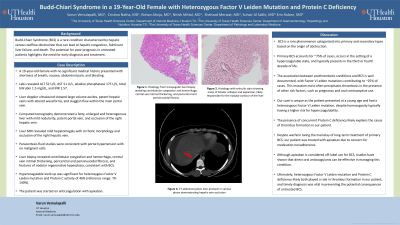Monday Poster Session
Category: Liver
P3129 - Budd-Chiari Syndrome in a 19-Year-Old Female With Heterozygous Factor V Leiden Mutation and Protein C Deficiency
Monday, October 28, 2024
10:30 AM - 4:00 PM ET
Location: Exhibit Hall E

Has Audio

Varun Vemulapalli, MD
University of Texas Health, McGovern Medical School
Houston, TX
Presenting Author(s)
Varun Vemulapalli, MD1, Cristina M. Natha, MD1, Rohan Ahuja, MD1, Nitish Mittal, MD1, Shehzad Merwat, MD2
1University of Texas Health, McGovern Medical School, Houston, TX; 2The University of Texas Health Sciences Center, Houston, TX
Introduction: Budd-Chiari Syndrome (BCS) is a rare condition characterized by hepatic venous outflow obstruction that can lead to hepatic congestion, fulminant liver failure, and death. The potential for poor prognosis in untreated patients highlights the need for early diagnosis and treatment.
Case Description/Methods: A 19-year-old female with no significant medical history presented with nausea and abdominal pain. Labs revealed ALT 52 U/L, AST 51 U/L, alkaline phosphatase 175 U/L, total bilirubin 1.5 mg/dL, and INR 1.57. Various imaging modalities showed large-volume ascites, heterogeneous liver with mild surface nodularity, globular liver areas with enhancement patterns favoring altered perfusion, and right hepatic vein outflow obstruction. Paracentesis fluid studies were consistent with portal hypertension. Liver biopsy revealed centrilobular congestion, central vein intimal thickening, peri-sinusoidal fibrosis, and features of nodular regenerative hyperplasia, consistent with BCS. Hypercoagulable work up was significant for heterozygous Factor V Leiden mutation and Protein C activity of 46%. The patient was started on anticoagulation with Eliquis.
Discussion: BCS is a rare phenomenon categorized into primary and secondary types based on the origin of obstruction. Primary BCS accounts for ~75% of cases, occurs in the setting of a hypercoagulable state, and typically presents in the third or fourth decade of life. The association between prothrombotic conditions and BCS is well documented, with Factor V Leiden mutations contributing to ~25% of cases. This mutation most often precipitates thrombosis in the presence of other risk factors, such as pregnancy and oral contraceptive use. Our case is unique as the patient presented at a young age and had a heterozygous Factor V Leiden mutation, despite homozygosity typically having a higher risk for hypercoagulability. The presence of concurrent Protein C deficiency likely explains the cause of thrombus formation in our patient. Despite warfarin being the mainstay of long-term treatment of primary BCS, our patient was treated with Eliquis due to concern for medication nonadherence. Although Eliquis is considered off-label use for BCS, studies have shown that direct oral anticoagulants can be effective in managing this condition. Ultimately, heterozygous Factor V Leiden mutation and Protein C deficiency likely both played a role in thrombus formation in our patient, and timely diagnosis was vital in preventing the potential consequences of untreated BCS.
Disclosures:
Varun Vemulapalli, MD1, Cristina M. Natha, MD1, Rohan Ahuja, MD1, Nitish Mittal, MD1, Shehzad Merwat, MD2. P3129 - Budd-Chiari Syndrome in a 19-Year-Old Female With Heterozygous Factor V Leiden Mutation and Protein C Deficiency, ACG 2024 Annual Scientific Meeting Abstracts. Philadelphia, PA: American College of Gastroenterology.
1University of Texas Health, McGovern Medical School, Houston, TX; 2The University of Texas Health Sciences Center, Houston, TX
Introduction: Budd-Chiari Syndrome (BCS) is a rare condition characterized by hepatic venous outflow obstruction that can lead to hepatic congestion, fulminant liver failure, and death. The potential for poor prognosis in untreated patients highlights the need for early diagnosis and treatment.
Case Description/Methods: A 19-year-old female with no significant medical history presented with nausea and abdominal pain. Labs revealed ALT 52 U/L, AST 51 U/L, alkaline phosphatase 175 U/L, total bilirubin 1.5 mg/dL, and INR 1.57. Various imaging modalities showed large-volume ascites, heterogeneous liver with mild surface nodularity, globular liver areas with enhancement patterns favoring altered perfusion, and right hepatic vein outflow obstruction. Paracentesis fluid studies were consistent with portal hypertension. Liver biopsy revealed centrilobular congestion, central vein intimal thickening, peri-sinusoidal fibrosis, and features of nodular regenerative hyperplasia, consistent with BCS. Hypercoagulable work up was significant for heterozygous Factor V Leiden mutation and Protein C activity of 46%. The patient was started on anticoagulation with Eliquis.
Discussion: BCS is a rare phenomenon categorized into primary and secondary types based on the origin of obstruction. Primary BCS accounts for ~75% of cases, occurs in the setting of a hypercoagulable state, and typically presents in the third or fourth decade of life. The association between prothrombotic conditions and BCS is well documented, with Factor V Leiden mutations contributing to ~25% of cases. This mutation most often precipitates thrombosis in the presence of other risk factors, such as pregnancy and oral contraceptive use. Our case is unique as the patient presented at a young age and had a heterozygous Factor V Leiden mutation, despite homozygosity typically having a higher risk for hypercoagulability. The presence of concurrent Protein C deficiency likely explains the cause of thrombus formation in our patient. Despite warfarin being the mainstay of long-term treatment of primary BCS, our patient was treated with Eliquis due to concern for medication nonadherence. Although Eliquis is considered off-label use for BCS, studies have shown that direct oral anticoagulants can be effective in managing this condition. Ultimately, heterozygous Factor V Leiden mutation and Protein C deficiency likely both played a role in thrombus formation in our patient, and timely diagnosis was vital in preventing the potential consequences of untreated BCS.
Disclosures:
Varun Vemulapalli indicated no relevant financial relationships.
Cristina Natha indicated no relevant financial relationships.
Rohan Ahuja indicated no relevant financial relationships.
Nitish Mittal indicated no relevant financial relationships.
Shehzad Merwat indicated no relevant financial relationships.
Varun Vemulapalli, MD1, Cristina M. Natha, MD1, Rohan Ahuja, MD1, Nitish Mittal, MD1, Shehzad Merwat, MD2. P3129 - Budd-Chiari Syndrome in a 19-Year-Old Female With Heterozygous Factor V Leiden Mutation and Protein C Deficiency, ACG 2024 Annual Scientific Meeting Abstracts. Philadelphia, PA: American College of Gastroenterology.
